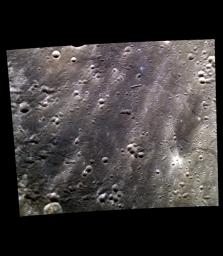This region in Mercury's northern mid-latitudes shows the rays of the crater Hokusai, along with the bright rays of a much smaller crater in the southeastern portion of the image. Rays are produced when material is excavated from a crater and "thrown" across the surface of a planet. The "butterfly" pattern of the smaller rayed crater is believed to be created during very low-angle impacts where material is ejected in an asymmetrical pattern.
This image was acquired as part of MDIS's high-resolution 3-color imaging campaign. The map produced from this campaign complements the 8-color base map (at an average resolution of 1 km/pixel) acquired during MESSENGER's primary mission by imaging Mercury's surface in a subset of the color filters at the highest resolution possible. The three narrow-band color filters are centered at wavelengths of 430 nm, 750 nm, and 1000 nm, and image resolutions generally range from 100 to 400 meters/pixel in the northern hemisphere.
Date acquired: February 01, 2013
Image Mission Elapsed Time (MET): 2001682, 2001674, 2001678
Image ID: 3436082, 3436080, 3436081
Instrument: Wide Angle Camera (WAC) of the Mercury Dual Imaging System (MDIS)
WAC filters: 9, 7, 6 (996, 748, 433 nanometers) in red, green, and blue
Center Latitude: 47.96°
Center Longitude: 7.84° E
Resolution: 131 meters/pixel
Scale: The crater along the southwestern edge of the image is 12.3 km in diameter (7.6 miles).
Incidence Angle: 48.0°
Emission Angle: 0.1°
Phase Angle: 47.9°
The MESSENGER spacecraft is the first ever to orbit the planet Mercury, and the spacecraft's seven scientific instruments and radio science investigation are unraveling the history and evolution of the Solar System's innermost planet. MESSENGER acquired over 150,000 images and extensive other data sets. MESSENGER is capable of continuing orbital operations until early 2015.
For information regarding the use of images, see the MESSENGER image use policy.

 Planetary Data System
Planetary Data System












